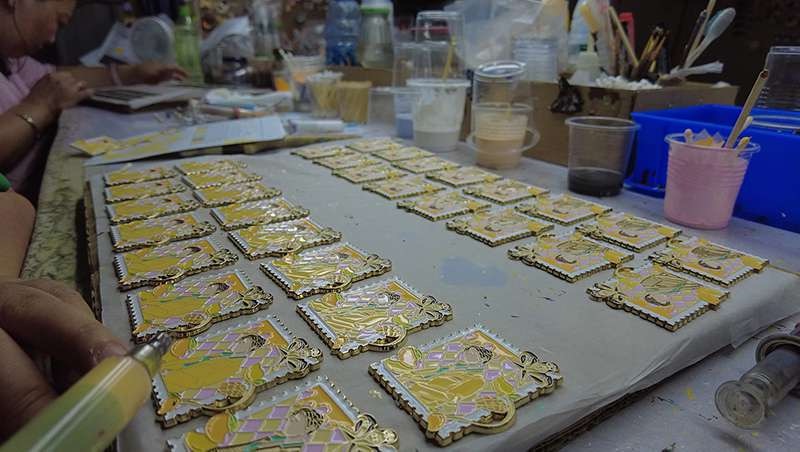Creating custom soft enamel pins involves several critical steps, from initial concept design to final production. This process typically includes five main stages: concept development, design creation, mold making, coloring, and finishing. Each stage is crucial to ensuring the final product meets the desired specifications and quality. In this article, we’ll take a detailed look at each of these steps, providing design tips and manufacturing insights to help you create stunning custom soft enamel pins.
Source:https://allaboutpins.com/soft-enamel-pins
Concept Development
The first step in making custom soft enamel pins is concept development. This involves brainstorming ideas and deciding on the overall theme, design elements, and purpose of the pin. Whether you’re creating pins for a corporate event, a promotional giveaway, or a personal collection, having a clear concept is essential.
Source:https://www.cleverclip.ch/en/blog/what-exactly-is-digital-design
1. Define Your Purpose
- Determine the goal of your custom soft enamel pins. Are they meant to promote a brand, commemorate an event, or serve as collectibles? Your purpose will guide the design process.
2. Research and Inspiration
- Look at existing pin designs for inspiration. Consider colors, shapes, and styles that resonate with your target audience.
3. Sketch Your Ideas
- Create rough sketches of your concepts. These initial drawings don’t have to be perfect but should convey the basic idea and layout of your custom soft enamel pins.
Design Creation
Once you have a solid concept, the next step is to create a detailed design. This involves refining your sketches and preparing them for production.
1. Digital Design Tools
- Use graphic design software like Adobe Illustrator or CorelDRAW to create a digital version of your pin design. Ensure your design is clean, precise, and scalable.
2. Consider Size and Detail
- Pay attention to the size of your custom soft enamel pins. Small pins require simpler designs with fewer intricate details to ensure clarity.
3. Choose Colors
- Select a color palette for your pins. Soft enamel pins use recessed areas filled with enamel paint, so consider how colors will appear when separated by metal borders.
4. Add Text and Logos
- If your custom soft enamel pins include text or logos, make sure they are legible and appropriately sized. Avoid overly intricate fonts or tiny text.
Mold Making
After finalizing the design, the next step is mold making. This involves creating a metal mold based on your digital design, which will be used to shape the pins.

Source:https://www.gs-jj.com/blog/enamel-pin-factory-production-process/
1. Creating the Mold
- The manufacturer will create a mold from your design, typically using a CNC machine or laser engraver. This mold will have raised and recessed areas corresponding to your design.
2. Quality Check
- Review the mold to ensure it accurately reflects your design. Any errors at this stage will affect the final product, so it’s crucial to get it right.
Coloring
With the mold ready, the pins are stamped out of metal and then colored. The recessed areas are filled with enamel paint to create the final design.

1. Metal Stamping
- The manufacturer uses the mold to stamp the pin shape out of a metal sheet, usually made from iron, brass, or zinc alloy.
2. Enamel Filling
- Soft enamel is applied to the recessed areas of the pin. This process can be done manually or with automated machines, depending on the complexity and quantity of the order.
3. Baking and Drying
- The pins are baked to harden the enamel, ensuring the colors are set and durable.
Finishing
The final step in creating custom soft enamel pins is finishing. This includes polishing, plating, and adding any necessary attachments.
1. Polishing
- The pins are polished to remove any excess enamel and to smooth out the surface. This gives the pins a shiny, professional appearance.
2. Plating
- Pins are plated with a metal finish, such as gold, silver, or black nickel. This step enhances the visual appeal and adds a layer of protection.
3. Attachments
- Attachments like butterfly clutches, rubber backs, or magnetic clasps are added to the back of the pins, making them easy to wear.
4. Quality Inspection
- Each pin undergoes a final quality inspection to ensure it meets the design specifications and quality standards. Any defective pins are discarded or reworked.

Understanding the various processes can help you better design soft enamel badges. The badge shown in the picture uses special effects such as 3D border, gold plating, glitter, trasparent, and sandblasting.
Conclusion
Creating custom soft enamel pins is a detailed and intricate process that transforms a concept into a tangible product. From concept development and design creation to mold making, coloring, and finishing, each step is essential to producing high-quality pins that stand out.
At BlythePin, we specialize in crafting exceptional custom soft enamel pins tailored to your needs. Our experienced team is dedicated to guiding you through every step of the process, ensuring your pins are designed and produced to perfection. Explore our services today and discover how we can help bring your vision to life with stunning custom soft enamel pins.



